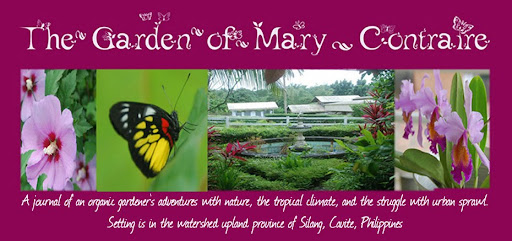MARCH 6, 2010
El Nino has dried up almost everything around me. Sparse water resources are being directed to those plants that are in dire need of moisture like the vanilla orchid vines, grapes, and my flowering plants. Other plants may have to wait for the rain.
My fruit trees are flowering and producing fruit too early.
The trees must sense the dry heat is going to deplete the ground water very quickly and its survival instrincts are stimulating the early flowering. Drawing from its roots, trees will direct moisture into propogating its species.
Early flowers will produce fruit very early in this summer heat. Fruits will develop seeds and in a month or two, these fruit trees seeds will start falling on the ground during times of drought .
When rains come in mid June or July, the seeds that fall, will sprout a new generation.
I am observing everything, and Mother Nature is teaching me to understand how it will surive inspite of the El Nino. Much of the hot air and dry heat is also caused by mans overdevelopment of upland rainforests that protect the watersheds into subdivisions, golf courses, commercial and industrial land.
Here are some photos of my farm in this dry, and very hot summer month that is just beginning.
 Covering seedlings with fish nets help conserve moisture. These bak-choy or pechay seedlings will not be able to survive the summer heat if these are not put into greenhouses where shade will prevent it from bolting.
Covering seedlings with fish nets help conserve moisture. These bak-choy or pechay seedlings will not be able to survive the summer heat if these are not put into greenhouses where shade will prevent it from bolting. Our cat HEART sniffs fish net and wonders where are the fish?
 SANGUMAY ORCHIDS LOVE HEAT, AND THEIR LAVENDER FLOWERS ARE JUST IN TIME FOR THE LENTEN SEASON. THEIR FRAGRANCE IS CARRIED IN THE AIR FOR SEVERAL METERS.
SANGUMAY ORCHIDS LOVE HEAT, AND THEIR LAVENDER FLOWERS ARE JUST IN TIME FOR THE LENTEN SEASON. THEIR FRAGRANCE IS CARRIED IN THE AIR FOR SEVERAL METERS.GOLDEN SHOWER ORCHIDS DISPLAY THEIR YELLOW BLOOMS
ON CAREFULLY TENDED VINES.
POLLINATION BY BENEFICIAL INSECTS WILL RESULT IN FRAGRANT PODS THAT WILL BE PLACED TOGETHER WITH COFFEE TO CREATE A NATURAL FLAVORED ICE COFFEE DRINK.
A REAL TREAT IN THIS SUMMER HEAT!
AND WHO CAN RESIST MANGA' HILAW WITH BAGOONG?
HARVEST OF ORGANICALLY GROWN MANGOS. GOOD TREES DON'T NEED CHEMICAL SPRAYS AND PESTICIDES. MANGOES HAVE A SAP THAT IS NATURALLY TOXIC TO INSECTS. THERE ARE NO ANTS GOING TO CRAWL ON THESE FRUITS!
THE ONCE GREEN FIELDS DRY OUT IN THE HEAT.
WHERE HAVE ALL THE FLOWERS GONE? EL NINO TOOK THEM!
My farm is going to survive, but conserving water means I will have less produce, just like most of the farms around me who are holding on to their land and hoping for a better harvest next year. COFFEE HARVESTED RIGHT BEFORE EL NINO ARRIVED THIS YEAR.
CORN CROP BOLTS IN THE HEAT
A LONE COW FEEDS HER CALF IN A FIELD




















